Occasional native food plants include sourwood (Oxydendrum arboreum (L.) DC.; Ericaceae), common buttonbush (Cephalanthus occidentalis L.; Rubiaceae), sassafras (Sassafras albidum (Nutt.) Nees; Lauraceae), wax myrtle (Morella cerifera (L.) Small; Myricaceae), ash (Fraxinus spp.; Oleaceae), blackgum (Nyssa sylvatica Marshall; Cornaceae), oak (Quercus spp.; Fagaceae), American sycamore (
Platanus occidentalis L.; Platanaceae), and willow (Salix spp.; Salicaceae) (Worth et al.
A census of all trees with a dbh [greater than or equal to] 20 cm revealed that the floodplain woodland is dominated by woody species commonly characteristic of this habitat, e.g., Acer negundo, Popuius deltoides, Acer succharinum,
Platanus occidentalis, Juglans nigra, Aescuius glabra, Celtis occidentalis, and Ulmus americana.
The fen was well shaded by sycamore (
Platanus occidentalis) , Arizona walnut (Juglans major), bald cypress (Taxodium distichum), and spicebush (Lindera benzoin).
Percent total mass is the contribution of each species or plant part from the total mass combined (both alien and native species) Number of nests (weight in grams) Outer Inner Species Common name layer layer Leaves Fagus grandifolia American Beech 18 (41.2) 17 (12.1) Acer rubrum Red maple 12 (6.7) 12 (5.1) Lindera benzoin Spicebush 7 (5.3) 10 (8.1) Liriodendron tulipifera Tulip poplar 11 (5.6) 12 (6.8)
Platanus occidentalis Sycamore 5 (7.8) 3 (1.7) Quercus velutina Black oak 0 5 (5.2) Quercus rubra N.
Segundo Reitz (1984), o Platanus x acerifolia e resultado do cruzamento genetico espontaneo entre o Platanus orientalis, originario do sudeste da Europa, Asia Menor, Ira, Afeganistao e noroeste da India e o
Platanus occidentalis L., que tem sua origem no sul do Canada e no leste dos Estados Unidos ate o Mexico, constituindo-se num hibrido de grande potencial madeireiro na regiao Sul do Brasil e tambem para outras regioes de clima temperado e frio.
On the cover is a "seed ball," the fruit of the American sycamore (
Platanus occidentalis).
In the United States, sycamore is a name reserved for several species of Platanus, among them
Platanus occidentalis, Platanus racemosa and Platanus wrightii.
These steep-sided ravines support a mesic forest of sugar maple, Fraxinus americana (white ash), and
Platanus occidentalis (sycamore), the largest trees about 75 cm dbh.
The forest cover is mixed, primarily consisting of maples (Acer), European black alder (Alnus glutinosa), black locust (Robinia pseudo-acacia), tree-of-heaven (Ailanthus altissima), autumn-olive (Elaeagnus umbellata), sycamore (
Platanus occidentalis), and red oak (Quercus rubra).
Other species included "cedar" = Ashe juniper (Juniperus ashei), blackjack [oak] (Quercus marilandica), "water oak" (species undetermined), "elm mott" = cedar elm (Ulmus crassifolia), and sycamore (
Platanus occidentalis).
 Platanus occidentalis - very large spreading plane tree of eastern and central North America to Mexico
Platanus occidentalis - very large spreading plane tree of eastern and central North America to Mexico